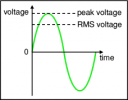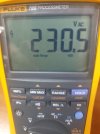OrganicZed
Fractal Fanatic
My wall voltage usually floats at about 117-118 volts.
Real engineers jump in here, but isn’t the voltage really an average with ac current? “Average” is not technically correct, but point being its never a constant value is it?Well I'll be damned! Just did a quick experiment..., turned on all 4 electric stove burners and the A/C kicked on, and it dropped to 120.
So do the power companies purposely send us higher than 120, to account for usage?
There is a voltage range they shoot for, and variance around that. Just like literally everything else in the analog world, there's the paper specification, and then there is the reality of what you actually receive, which sometimes coincide exactly, but mosly only approximate the specification....Real engineers jump in here, but isn’t the voltage really an average with ac current? “Average” is not technically correct, but point being its never a constant value is it?
Real engineers jump in here, but isn’t the voltage really an average with ac current? “Average” is not technically correct, but point being its never a constant value is it?

Is that all Edison could do for you?I'm just curious..., I've noticed in many rig pics, the AC voltage always seems to be higher than 120. Like I just saw one that was @ 125. Mine is always around 122.
Anyone know why that seems to be the norm?

Edison pushed for a DC based system, which was pretty limited in comparison to the further reaching AC system Tesla/Westinghouse pushed for. Crazy bastard supposedly used to electrocute animals using AC to show how dangerous it was and scare people away from it. He supposedly even killed an elephant once, though it's been debated if he actually had anything to do with it. His business practices were questionable to say the least.Is that all Edison could do for you?
You guys are running low
View attachment 88094
Between 230.4V and 230.5V here
Contrary to popular belief, the US does use a 240 Volt system. We just use a center tapped transformer to split it into two opposing phases and put some circuits on one phase and some on the other with a grounded neutral conductor between them. Some high current large appliances like stoves, ovens, air conditioners, clothes driers, etc. bridge both phases together and operate on 240 volts directly.
Contrary to popular belief, the US does use a 240 Volt system. We just use a center tapped transformer to split it into two opposing phases and put some circuits on one phase and some on the other with a grounded neutral conductor between them. Some high current large appliances like stoves, ovens, air conditioners, clothes driers, etc. bridge both phases together and operate on 240 volts directly.
Yep. The really large transmission lines usually have multiples of 3 wires, and even the lower voltage poles along 2-lane roads carry the 3-phase up on top. If you look up, every so often you'll see a pole-mounted, step-down transformer, which drops the voltage down to 120, then sends a leg of each to residences. In newer areas, the transformers are surface-mount (those big green boxes), and the redidential lines are underground.Yeah, 3 phase is also used here in the US, but mostly for industrial applications or for feeding substations and really large buildings. That's why you'll usually see three separate wires on transmission lines, one for each phase.
Gotta have the 220/221 joke whenever talking about electricity!
Yeah small players there in the US. In our place at least we know and d d d d d d d remember when we to to to to to to touch a live lead...Is that all Edison could do for you?
You guys are running low
View attachment 88094
Between 230.4V and 230.5V here
